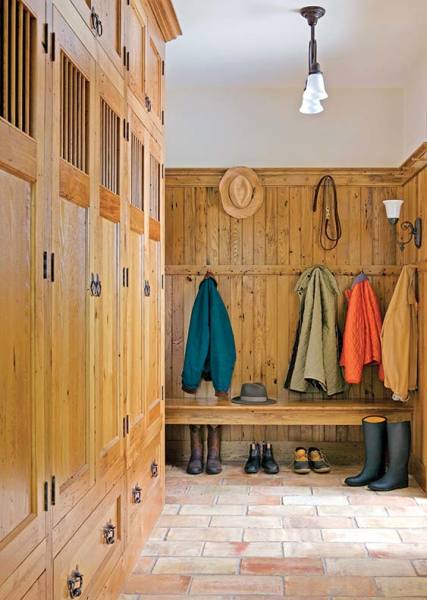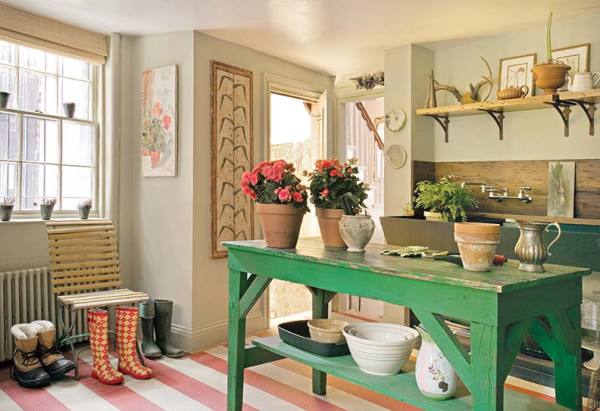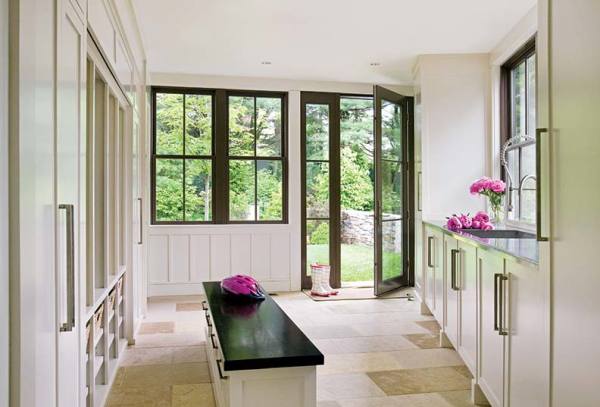A combination of warm wood tones and brick flooring make this a handsome entry.
Wet footprints, muddy shoes, tracked-in dirt, clinging grass—a mudroom accommodates and mitigates all of a home’s unpleasant unmentionables. By corralling coats, shoes, umbrellas, and any number of castoffs, the utilitarian space acts as a buffer between outdoor activities and indoor cleanliness.
Origins & Location
Historically, mud areas originated in rural settings where roads were unpaved and boots perennially muddy. They were usually just a small vestibule off the kitchen on the backside of a manor or farmhouse. It wasn’t until the 1980s when the mudroom grew larger and became “formalized” into a dedicated space, notes Massachusetts-based architect Sheldon Kostelecky. Today’s mudroom is typically sited in between the garage and kitchen, where it acts as a connecting “hyphen” space, notes Kostelecky.
Optimizing Storage
Determining the types of items destined for residency, and whether or not they should be hidden behind cabinet doors or neatly displayed, is the first step in designing a successful mudroom. If everything has its place, then the area can appear tidy even while brimming with an eclectic variety of odds and ends.
When Kostelecky tackles an initial layout, he begins by asking his clients how they live and what their family culture is like. “Formal versus casual, young children versus high school age, active in sports or not—most families need lots of storage bins and coat closets; sometimes we even assign each family member their own closet,” explains the architect.
Mudrooms often have multiple purposes, such as storage for boots and gardening equipment.
Custom cabinets are ideal because they are adaptable: A designer or craftsman can draft a personalized set of cabinets that fit dexterously into corners or between doors. Built-in arrangements include floor-to-ceiling “locker style” cabinets, rows of cubbies for baskets, window seats, and even bases for sinks and countertops. A bench is an ideal resting place for taking off shoes, and when designed as a full built-in, delivers extra storage with a hinged top.
Design Possibilities
“The detailing, materials, and finishes of built-ins should match those in the main house but in a more durable, simple, and informal way,” says Kostelecky. “A good source for detailing such a functional room would be to look at historic butler’s pantries. They were used every day by staff and needed to be functional and, most importantly, easy to clean.”
Stained and lacquered hardwood such as oak is a “forever” choice for built-ins if the house style warrants the look. As Kostelecky points out, Colonial Revival homes in the early 20th century generally incorporated painted millwork with recessed or raised panels. Milk paint, common to historic kitchens and furniture, is also a period-appropriate choice and virtually indestructible, he adds.
When choosing countertops, opt for materials traditionally used in historic homes, recommends Kostelecky, such as granite, soapstone, slate, ceramic tile, quarry tile, wood, and sheet metal such as copper, nickel silver, or even stainless steel.
This mudroom was designed by New England architect Mark Hutker.
Even in a formal house, mudrooms should have hard-wearing, easy-to-mop flooring. Material options include stone slabs, brick pavers, and quarry tile (all require sealing). If budget is a concern, ceramic tile is an option, but the tiles should be large in size in order to minimize joints, which need periodic cleaning. Area rugs can help soften the look of stone or tile, but should be tough and stain-resistant. Similarly, cushion fabrics should also be easy to clean: Thick tapestry-style fabric and even leather are both practical options that hold up well over time.
When it comes to lighting, function is more important than décor—opt for simple fixtures that are “back of the house” in design. Recessed down lights, surface-mounted lights, sconces, and pendants are good choices but should be period-appropriate. Workstations, such as sinks and desks, benefit from additional task lighting, ideally hidden away underneath cabinets or shelving.
Creative Uses
“The mudroom has evolved into a catch-all, multipurpose room used by all members of a family,” says Kostelecky. If space allows, it can accommodate almost any type of task. For busy families on the go, plenty of hooks for coats and bags, and shelves for shoes are in order. The mudroom is also a practical setting for pet accoutrements: feeding dishes, cat litter, leashes, brushes, toys, and food. Avid gardeners might incorporate a potting area, which usually requires the addition of an industrial-style sink such as a farmhouse-style slop sink made from stone slabs. Some mudrooms even contain a laundry area, in which case a row of upper cabinets above the machines can house detergents, irons, and other paraphernalia.
A small closet for mops, vacuums, and other cleaning equipment keeps these utilitarian objects from cluttering up the pantry. Baskets, arranged either on shelves or inside cabinets, are perfect for grouping miscellaneous accessories such as hats, gloves, art supplies, and small sports equipment. Open shelving is not only period appropriate but is ideal for displaying bulky items such as vases or ceramic pots.
If mail organization is a constant hassle, then a counter or more expansive desk is appropriate. Bulletin boards can group grocery lists and school projects, blackboards can shout daily reminders, and specialized pegboards can keep garden and other hobby tools organized and within easy reach.
Architects and designers have warmed to the mudroom, acknowledging its ability to streamline busy lifestyles. At heart, it is a space where form meets function and where modesty trumps drama. It should be no more or less than a tidy package of modern features and traditional simplicity.







